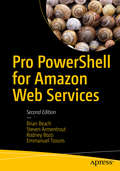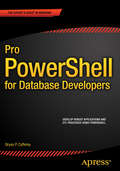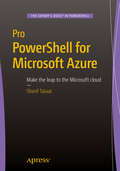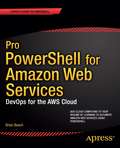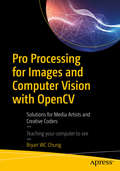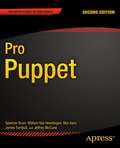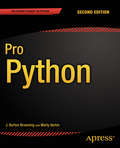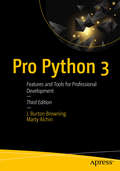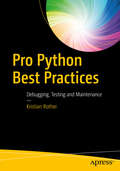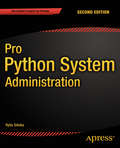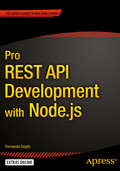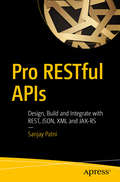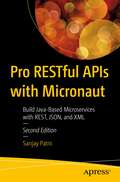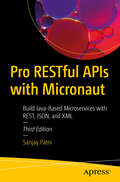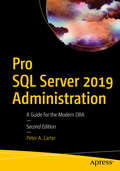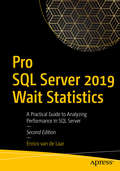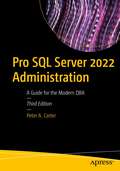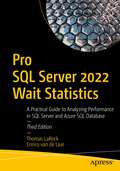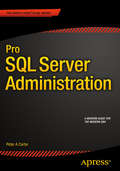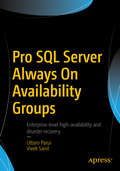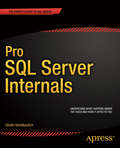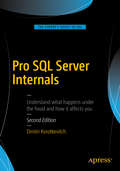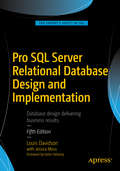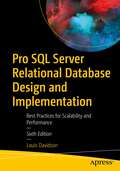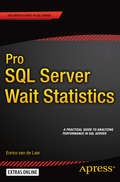- Table View
- List View
Pro PowerShell for Amazon Web Services: Devops For The Aws Cloud
by Brian Beach Steven Armentrout Rodney Bozo Emmanuel TsourisAmazon Web Services (AWS) is the leading public cloud platform. In this book you will learn to use Microsoft PowerShell to create, host, manage, and administer workloads using Amazon Web Services. You will learn how to create virtual machines, provision storage, configure networks, and more—all using your preferred Windows scripting language. CIOs everywhere are leading their organizations to the cloud, but there are few books available to help. This book focuses on moving Microsoft Windows workloads to the cloud using technologies familiar to enterprise Microsoft-based professionals. The completely revised and expanded Pro PowerShell for Amazon Web Services is written specifically for Windows professionals who already know PowerShell and want to learn to host Windows workloads on Amazon Web Services. The cloud offers information technology workers significant cost savings and agility unimaginable even just a few years ago. Tasks that traditionally took weeks of work, costing thousands of dollars, can be completed in minutes for a fraction of a penny. New chapters in this second edition cover: AWS Lambda, Amazon WorkSpaces, Amazon AppStream 2.0, AWS Directory Service, Amazon WorkDocs, and AWS System Manager.What You'll LearnCreate and manage Windows servers on Elastic Compute Cloud (EC2)Configure and secure networks with Virtual Private Cloud (VPC)Leverage autoscaling to adjust resources as load changesDeploy and manage SQL Server using the Relational Database Service (RDS)Manage virtual desktops using WorkSpaces and AppStreamLeverage AWS Systems Manager to manage Windows at scale Who This Book Is ForWindows professionals who want to learn more about Amazon Web Services, with a focus on running Windows workloads and automated management at scale using PowerShell tools for AWS. The book assumes you have knowledge of Windows and PowerShell, but are new to AWS.
Pro PowerShell for Database Developers
by Bryan CafferkyPro PowerShell for Database Developers helps you master PowerShell application development by continuing where other books leave off. There are no "Hello World" functions here, just real-world examples that get down to business. Develop and deploy database and ETL applications in a reusable framework. Read from any data source and write to any destination. Integrate PowerShell with SQL Server. Pro PowerShell for Database Developers shows how to dive into the PowerShell environment and customize it to your needs. Learn about CmdletBinding and its use in extending functions with powerful new features. Also learn to package functions into libraries called modules that are loaded automatically on demand. PowerShell is about automation and getting work done when you're not around to perform it. To that end you'll see how to schedule PowerShell applications using SQL Agent and the scheduled job cmdlets. And for when you are around to run automated processes in person, you'll learn to add a Windows GUI to your applications to give them that professional polish. Other exciting topics include: Creating objects with custom methods and properties and extending them with PowerShell-style inheritance. Implementing function polymorphism using parameter sets. Using PowerShell as an ETL tool surpassing even SSIS. Creating distributed, interruptible, and multithreaded programs using PowerShell's workflow engine and the . Net Windows Workflow Foundation. All these topics are explained using real-world examples encapsulated into modules you can immediately put to use in your organization. You'll reap even more as you come to grips with all that PowerShell can do. Begin the journey toward deep expertise and amazing productivity. Buy and read Pro PowerShell for Database Developers today. What you'll learn Develop professional, reliable, extensible, and flexible code. Customize the PowerShell environment and language to your needs. Code using advanced features such as COM and . NET objects. Write complete applications involving database access and GUIs, all in PowerShell. Run PowerShell as a stand-alone ETL tool, and also to manage ETL process flow. Access the Windows Workflow API for writing multi-threaded applications in PowerShell. Who this book is for Pro PowerShell for Database Developers is for . NET and other developers using PowerShell in connection with database-backed applications, and especially with the sort of databases commonly found in enterprise environments. If you're wondering what all the PowerShell hype is about, if you're wanting to get serious about using PowerShell well beyond writing trivial scripts, then Pro PowerShell for Database Developers is the book to read. Table of Contents Introduction 1. Grasping PowerShell Basics 2. Introducing the Language 3. Learning Advanced Features 4. Writing Simple Scripts 5. Creating Reusable Code 6. Extending PowerShell 7. Accessing SQL Server 8. Customizing the PowerShell Environment 9. Augmenting ETL Processes 10. PowerShell Application Configurations, Development Best Practices and Application Deployment 11. PowerShell versus SSIS 12. PowerShell Jobs 13. Multi-threading with Wndows Workflow
Pro PowerShell for Microsoft Azure
by Sherif TalaatThis book is written for Windows professionals who are familiar with PowerShell and want to learn to build, operate, and administer their Windows workloads in the Microsoft cloud. Pro PowerShell for Microsoft Azure is packed with practical examples and scripts, with easy-to-follow explanations for a wide range of day-to-day needs and essential administration tasks. Author Sherif Talaat begins by explaining the fundamental concepts behind the Microsoft Azure platform and how to get started configuring it through PowerShell. Readers will find out how to deploy, configure and manage the various components of the Azure platform, from storage and virtual networks to Azure Web Apps, HDInsight clusters and the Azure SQL Database. Workload automation, scheduling and resource management are covered in depth to help build efficiency in everyday tasks, and administrators will gain full control over Azure identity and access rights using Azure Active Directory and Rights Management Services. Put your PowerShell skills to good use and ensure that your applications and data are available anywhere at any time, with Pro PowerShell for Microsoft Azure. What you'll learn Create and manage virtual networks and VPNs using PowerShell. Configure and maintain Azure Storage accounts, blobs, and containers. Provision and manage a redundant Windows or Linux server. Deploy and configure your applications in the cloud using Microsoft Azure Web Apps. Provision Apache Hadoop clusters in the cloud using Azure HDInsight. Deploy, configure and manage a Microsoft Azure SQL Database. Protect and secure identities and resources with Azure Active Directory and Azure Rights Management Services. Who this book is for This is book is for the intermediate to advanced Windows professional who is ready to make the leap to the cloud. Table of Contents Chapter 1: Azure Architecture Overview Chapter 2: Getting Started with Azure PowerShell Chapter 3: Managing and Maintaining Azure Storage Chapter 4: Virtual Machines Deployment and Management Chapter 5: Virtual Networking Configuration Chapter 6: Deploying Azure Web Apps Chapter 7: Azure SQL Database Chapter 8: Azure Automation Chapter 9: Azure RemoteApp Chapter 10: Azure Identity and Access Chapter 11: Azure Rights Management Service Chapter 12: Building and Managing Azure HDInsight Clusters
Pro Powershell for Amazon Web Services
by Brian BeachPro PowerShell for Amazon Web Services is written specifically for Windows professionals who already know PowerShell and want to learn to host Windows workloads in the Amazon Elastic Cloud Compute (EC2) cloud service. The cloud offers information technology workers significant cost savings and agility unimaginable even just a few years ago. Tasks that traditionally took weeks of work, costing thousands of dollars, can be completed in minutes for a fraction of a penny. This book is a resource for using Microsoft's powerful scripting language, PowerShell, to create, host, manage, and administer workloads using a service widely recognized as the industry leader in cloud computing. Inside, find scripts to create and manage virtual machines, provision storage, configure networks with agility, and more--all using your preferred Windows scripting language. Use your PowerShell knowledge to harness the power of Amazon EC2 today! What you'll learn Create, manage, and terminate Windows servers in the cloud Manage storage options including backup and recovery Configure a virtual network including subnets and route tables Secure your servers using security groups and access control lists Use Auto Scaling to respond to changing conditions Deploy SQL Server using Relational Database Service Use Simple Storage Service (S3) to reliably store and archive data Control access to resources using Identity and Access Management (IAM) Who this book is for Pro PowerShell for Amazon Web Services is for the intermediate to advanced Windows professional who is ready to make the leap to the Amazon cloud. Table of Contents Chapter 1 AWS Architecture Overview Chapter 2 Getting Started Chapter 3 Basic Instance Management Chapter 4 Elastic Block Storage Chapter 5 Virtual Private Cloud Chapter 6 Advanced Instance Management Chapter 7 Amazon Machine Images Chapter 8 Monitoring and High Availability Chapter 9 Relational Database Service Chapter 10 Simple Storage Service Chapter 11 Identity and Access Management Chapter 12 Glossary of Terms Chapter 13 Metadata URL Structure Chapter 14 List of Filters by EC2 Command Chapter 15 List of API Methods by Command Chapter 16 CloudWatch Metrics and Dimensions Chapter 17 SQL Server RDS Parameters
Pro Processing for Images and Computer Vision with OpenCV: Solutions for Media Artists and Creative Coders
by Bryan Wc ChungApply the Processing language to tasks involved in computer vision--tasks such as edge and corner detection, recognition of motion between frames in a video, recognition of objects, matching of feature points and shapes in different frames for tracking purposes, and more. You will manipulate images through creative effects, geometric transformation, blending of multiple images, and so forth. Examples are provided.Pro Processing for Images and Computer Vision with OpenCV is a step-by-step training tool that guides you through a series of worked examples in linear order. Each chapter begins with a basic demonstration, including the code to recreate it on your own system. Then comes a creative challenge by which to engage and develop mastery of the chapter’s topic. The book also includes hints and tips relating to visual arts, interaction design, and industrial best practices.This book is intended for any developer of artistic and otherwise visual applications, such as in augmented reality and digital effects, with a need to manipulate images, and to recognize and manipulate objects within those images. The book is specifically targeted at those making use of the Processing language that is common in artistic fields, and to Java programmers because of Processing’s easy integration into the Java programming environment. What You'll LearnMake use of OpenCV, the open source library for computer vision in the Processing environmentCapture live video streams and examine them frame-by-frame for objects in motionRecognize shapes and objects through techniques of detecting lines, edges, corners, and moreTransform images by scaling, translating, rotating, and additionally through various distortion effectsApply techniques such as background subtraction to isolate motion of objects in live video streamsDetect and track human faces and other objects by matching feature points in different images or video framesWho This Book Is ForMedia artists, designers, and creative coders
Pro Puppet
by Spencer Krum William Van Hevelingen Ben Kero James Turnbull Jeffery MccunePro Puppet, Second Edition, now updated for Puppet 3, is an in-depth guide to installing, using, and developing the popular configuration management tool Puppet. Puppet provides a way to automate everything from user management to server configuration. You'll learn how Puppet has changed in the latest version, how to use it on a variety of platforms, including Windows, how to work with Puppet modules, and how to use Hiera. Puppet is a must-have tool for system administrators, and Pro Puppet will teach you how to maximize its capabilities and customize it for your environment. Install and configure Puppet to immediately start automating tasks and create reporting solutions Learn insider tricks and techniques to better manage your infrastructure Become a Puppet expert! What you'll learn How to use Puppet to administer Linux, Unix, and Windows systems Best practices for at-scale deployment How to write reusable puppet modules for yourself and for the community How to use numerous tools around Puppet such as rspec-puppet, Geppetto, and PuppetDB Advanced Puppet Features such as Hiera and Mcollective Who this book is for System administrators who need to quickly get into the details of configuration management with Puppet. You don't need previous Puppet experience, but it will help if you've had some experience with configuration management. For errata to this book, please visit the authors' error github at: https://github. com/pro-puppet/pro-puppet-errata Table of Contents Getting Started with Puppet Building Hosts with Puppet Working with Environments Scaling Puppet Externalizing Puppet Configuration Exporting and Storing Configuration Puppet Consoles Tools and Integration Reporting with Puppet Extending Facter and Puppet MCollective Hiera: Separating Data From Code
Pro Python
by Marty Alchin J. Burton BrowningYou've learned the basics of Python, but how do you take your skills to the next stage? Even if you know enough to be productive, there are a number of features that can take you to the next level in Python. Pro Python, Second Edition explores concepts and features normally left to experimentation, allowing you to be even more productive and creative. In addition to pure code concerns, Pro Python develops your programming techniques and approaches, which will help make you a better Python programmer. This book will improve not only your code but also your understanding and interaction with the many established Python communities. This book takes your Python knowledge and coding skills to the next level. It shows you how to write clean, innovative code that will be respected by your peers. With this book, make your code do more with introspection and meta-programming. And learn and later use the nuts and bolts of an application, tier-by-tier as a complex case study along the way. For more information, including a link to the source code referenced in the book, please visit http: //propython. com/.
Pro Python 3: Features and Tools for Professional Development
by Marty Alchin J. Burton BrowningRefine your programming techniques and approaches to become a more productive and creative Python programmer. This book explores the concepts and features that will improve not only your code but also your understanding of the Python community with insights and details about the Python philosophy.Pro Python 3, Third Edition gives you the tools to write clean, innovative code. It starts with a review of some core Python principles, which are illustrated by various concepts and examples later in the book. The first half of the book explores aspects of functions, classes, protocols, and strings, describing techniques which may not be common knowledge, but which together form a solid foundation. Later chapters cover documentation, testing, and app distribution. Along the way, you’ll develop a complex Python framework that incorporates ideas learned throughout the book.Updates in this edition include the role of iterators in Python 3, web scraping with Scrapy and BeautifulSoup, using Requests to call web pages without strings, new tools for distribution and installation, and much more. By the end of the book you'll be ready to deploy uncommon features that can take your skills to the next level in Python.What You’ll LearnImplement programs with various types of Python functionsWork with classes and object-oriented programmingUse strings from the standard library and third-party librariesHarvest web site data with PythonAutomate unit testing by writing a test suiteReview imaging, random number generation, and NumPy scientific extensionsUnderstand The Zen of Python documentation to help you decide the best way to distribute your codeWho This Book Is ForIntermediate programmers familiar with Python who are looking to move to an advanced level. You should have written at least a simple Python application, and be comfortable with a basic object-oriented approach, using the interactive interpreter, and writing control structures.
Pro Python Best Practices
by Kristian RotherLearn software engineering and coding best practices to write Python code right and error free. In this book you'll see how to properly debug, organize, test, and maintain your code, all of which leads to better, more efficient coding. Software engineering is difficult. Programs of any substantial length are inherently prone to errors of all kinds. The development cycle is full of traps unknown to the apprentice developer. Yet, in Python textbooks little attention is paid to this aspect of getting your code to run. At most, there is a chapter on debugging or unit testing in your average basic Python book. However, the proportion of time spent on getting your code to run is much higher in the real world. Pro Python Best Practices aims to solve this problem. What You'll Learn Learn common debugging techniques that help you find and eliminate errors Gain techniques to detect bugs more easily Learn techniques to keep your project under control Who This Book Is For Experienced Python coders from web development, big data, and more.
Pro Python System Administration
by Rytis SileikaAs time goes on, system administrators are presented with increasingly complicated challenges. In the early days, a team of engineers might have had to look after one or two systems. These days, one engineer can administer hundreds or thousands of systems. System administrators are gradually replacing their tools with more advanced and flexible ones. One of the choices is Python. Structurally, Python is a modern, high-level language with a very clean syntax. Python comes with many built-in libraries that can make automation tasks easier. It also has extensive set of third-party libraries and a very active development community. This flexibility makes Python a good choice for a wide variety of tasks, from prototyping science applications to system maintenance and administration jobs. This book explains and shows how to apply Python scripting in practice. Unlike the majority of the Python books, it will show you how to approach and resolve real-world issues that most system administrators will come across in their careers. In this book, you will find several projects in the categories of network administration, web server administration, and monitoring and database management. In each project, we will define the problem, design the solution, and go through the more interesting implementation steps. Each project is accompanied with the source code of a fully working prototype, which you'll be able to use immediately or adapt to your requirements and environment. What you'll learn Solve real-world system administration problems using Python. Manage devices with SNMP and SOAP. Build a distributed monitoring system. Manage web applications and parse complex log files. Automatically monitor and manage MySQL databases. Who this book is for This book is primarily aimed at experienced system administrators whose day-to-day tasks involve looking after and managing small-to-medium-sized server estates. It will also be beneficial for system administrators who want to learn more about automation and want to apply their Python knowledge to solve various system administration problems. Python developers will also benefit from reading this book, especially if they are involved in developing automation and management tools. This book assumes that readers already use Python and are comfortable with the language. Most of the Linux distributions come with Python and various libraries (such as Django, PIL and SciPy) packaged and readily available, but basic knowledge of installing packages in a Linux/Unix environment is advised. Table of Contents Reading and Collecting Performance Data Using SNMP1 Managing Devices Using the SOAP API Creating a Web Application for IP Address Accountancy Integrating the IP Address Application with DHCP Maintaining a List of Virtual Hosts in an Apache Configuration File Gathering and Presenting Statistical Data from Apache Log Files Performing Complex Searches and Reporting on Application Log Files A Web Site Availability Check Script for Nagios Management and Monitoring Subsystem Remote Monitoring Agents Statistics Gathering and Reporting Automatic MySQL Database Performance Tuning Using Amazon EC2/S3 as a Data Warehouse Solution
Pro REST API Development with Node.js
by Fernando DoglioPro REST API Development with Node. js is your guide to managing and understanding the full capabilities of successful REST development. API design is a hot topic in the programming world, but not many resources exist for developers to really understand how you can leverage the advantages. This book will provide a brief background on REST and the tools it provides (well known and not so well known). Understand how there is more to REST than just JSON and URLs. You will then cover and compare the maintained modules currently available in the npm community, including Express, Restify, Vatican, and Swagger. Finally you will code an example API from start to finish, using a subset of the tools covered. The Node community is currently flooded with modules; some of them are published once and never updated again - cluttering the entire universe of packages. Pro REST API Development with Node. js shines light into that black hole of modules for the developers trying to create an API. Understand REST API development with Node. js using this book today. What you'll learn What REST really is and how you can use it to your advantage. How to use a variety of modules including JSON/Hal, Express, Restify, Vatican, and Swagger. How to build an example RESTful API from start to finish. How to troubleshoot any problems and move on with your API. Who this book is for This is book is designed for any Node. js developer who wants to fully understand REST API development. So often, the true capabilities of this method are not fully understood. This book will shed light on all aspects and make REST API development easy. Table of Contents Introduction Chapter One: REST 101 Chapter Two: API Design Best Practices Chapter Three: Node. js and REST Chapter Four: Architecting a REST API Chapter Five: Working with Modules Chapter Six: Planning Your REST API Chapter Seven: Developing Your REST API Chapter Eight: Troubleshooting
Pro RESTful APIs
by Sanjay PatniDiscover the RESTful technologies, including REST, JSON, XML, JAX-RS web services, SOAP and more, for building today's microservices, big data applications, and web service applications. This book is based on a course the Oracle-based author is teaching for UC Santa Cruz Silicon Valley which covers architecture, design best practices and coding labs. Pro RESTful APIs: Design gives you all the fundamentals from the top down: from the top (architecture) through the middle (design) to the bottom (coding). This book is a must have for any microservices or web services developer building applications and services. What You'll Learn Discover the key RESTful APIs, including REST, JSON, XML, JAX, SOAP and more Use these for web services and data exchange, especially in today's big data context Harness XML, JSON, REST, and JAX-RS in examples and case studies Apply best practices to your solutions' architecture Who This Book Is For Experienced web programmers and developers.
Pro RESTful APIs with Micronaut: Build Java-Based Microservices with REST, JSON, and XML
by Sanjay PatniDiscover the RESTful technologies, including REST, JSON, XML, JAX-RS web services, SOAP and more, for building today's Java-based microservices, big data applications, and web service applications using the Micronaut framework. This book is based on a course the Oracle-based author is teaching for UC Santa Cruz Silicon Valley which covers architecture, design best practices and coding labs.Pro RESTful APIs with Micronaut (Second Edition) gives you all the fundamentals from the top down: from the top (architecture) through the middle (design) to the bottom (coding). This book is a must have for any microservices or web services application programmer or developer building applications and services for today's enterprises. After reading and using this book, you'll be competent in using Micronaut and RESTful APIs for building today's microservices. Source code for the examples and case studies are free and available on Apress' GitHub page for this book.What You'll LearnDiscover the key RESTful APIs, including REST, JSON, XML, JAX, SOAP and moreExplore the Micronaut frameworkUse these for microservices for today's modern web services and data exchangesHarness Java, XML, JSON, REST, and JAX-RS in examples and case studiesApply best practices to your solutions’ architecture and moreWho This Book Is ForExperienced Java and web programmers and developers who may be new to microservices and even cloud-native applications development.
Pro RESTful APIs with Micronaut: Build Java-Based Microservices with REST, JSON, and XML
by Sanjay PatniDiscover the RESTful technologies, including REST, JSON, XML, JAX-RS web services, SOAP, and more, for building today's Java-based microservices, big data applications, and web service applications using the Micronaut framework. This book is based on a course the Oracle-based author is teaching for UC Santa Cruz Silicon Valley which covers architecture, design best practices, and coding labs. This book gives you all the fundamentals from the top down: from the top (architecture) through the middle (design) to the bottom (coding). This third edition is updated with chapters on Micronaut JAX-RS and Micronaut Security, along with overall code updates to account for Micronaut 4. This book is a must have for any microservices or web services application programmer or developer building applications and services for today's enterprises. After reading and using this book, you'll be competent in using Micronaut and RESTful APIs for building today's microservices. Source code for the examples and case studies is provided. What You Will Learn Discover the key RESTful APIs, including REST, JSON, XML, JAX, SOAP, and more Explore the Micronaut framework Use RESTful APIs for microservices for today's modern web services and data exchanges Harness Java, XML, JSON, REST, and JAX-RS in examples and case studies Apply best practices to your solution architecture and more Who This Book Is For Experienced Java and web programmers and developers who may be new to microservices and even cloud-native applications development
Pro SQL Server 2019 Administration: A Guide for the Modern DBA
by Peter A. CarterUse this comprehensive guide for the SQL Server DBA, covering all that practicing database administrators need to know to get their daily work done. Updated for SQL Server 2019, this edition includes coverage of new features such as Memory-optimized TempDB Metadata, and Always Encrypted with Secure Enclaves. Other new content includes coverage of Query Store, resumable index operations, installation on Linux, and containerized SQL.Pro SQL Server 2019 Administration takes DBAs on a journey that begins with planning their SQL Server deployment and runs through installing and configuring the instance, administering and optimizing database objects, and ensuring that data is secure and highly available. Finally, readers will learn how to perform advanced maintenance and tuning techniques.This book teaches you to make the most of new SQL Server 2019 functionality, including Data Discovery and Classification. The book promotes best-practice installation, shows how to configure for scalability and high workloads, and demonstrates the gamut of database-level maintenance tasks such as index maintenance, database consistency checks, and table optimizations. What You Will LearnInstall and configure SQL Server on Windows through the GUI and with PowerShell Install and configure SQL Server on Linux and in ContainersOptimize tables through in-memory OLTP, table partitioning, and the creation of indexesSecure and encrypt data to protect against embarrassing data breachesEnsure 24x7x365 access through high-availability and disaster recovery featuresBack up your data to ensure against loss, and recover data when neededPerform routine maintenance tasks such as database consistency checks Troubleshoot and solve performance problems in SQL queries and in the database engineWho This Book Is ForSQL Server DBAs who manage on-premise installations of SQL Server. This book is also useful for DBAs who wish to learn advanced features such as Query Store, Extended Events, Distributed Replay, and Policy-Based Management, or those who need to install SQL Server in a variety of environments.
Pro SQL Server 2019 Wait Statistics: A Practical Guide to Analyzing Performance in SQL Server
by Enrico van de LaarHere is a practical guide for analyzing and troubleshooting SQL Server performance using wait statistics. Learn to identify precisely why your queries are running slowly. Measure the amount of time consumed by each bottleneck so that you can focus attention on making the largest improvements first. This edition is updated to cover analysis of wait statistics inside Query Store, the CXCONSUMER wait event, and to be current with SQL Server 2019. Whether you are new to wait statistics, or already familiar with them, this book provides a deeper understanding on how wait statistics are generated and what they can mean for your SQL Server instance’s performance. Pro SQL Server 2019 Wait Statistics goes beyond the most common wait types into the more complex and performance-threatening wait types. You’ll learn about per-query wait statistics and session-based wait statistics, and the types of problems they each can help you solve. The different wait types are categorized by their area of impact, including CPU, IO, Lock, and many more.The book presents clear examples to help you gain practical knowledge of why and how specific wait times increase or decrease, and how they impact your SQL Server’s performance. After reading this book you won’t want to be without the valuable information that wait statistics provide regarding where you should be spending your limited tuning time to maximize performance and value to your business. What You'll LearnIdentify resource bottlenecks in a running SQL Server instanceLocate wait statistics information inside DMVs and Query StoreAnalyze the root cause of sub-optimal performanceDiagnose I/O contention and locking contentionBenchmark SQL Server performanceLower the wait time of the most popular wait typesWho This Book Is ForDatabase administrators who want to identify and resolve performance bottlenecks, those who want to learn more about how the SQL Server engine accesses and uses resources inside SQL Server, and administrators concerned with achieving—and knowing they have achieved—optimal performance
Pro SQL Server 2022 Administration: A Guide for the Modern DBA
by Peter A. CarterGet your daily work done efficiently using this comprehensive guide for SQL Server DBAs that covers all that a practicing database administrator needs to know. Updated for SQL Server 2022, this edition includes coverage of new features, such as Ledger, which provides an immutable record of table history to protect you against malicious data tampering, and integration with cloud providers to support hybrid cloud scenarios. You’ll also find new content on performance optimizations, such as query pan feedback, and security controls, such as new database roles, which are restructured for modern ways of working. Coverage also includes Query Store, installation on Linux, and the use of containerized SQL.Pro SQL Server 2022 Administration takes DBAs on a journey that begins with planning their SQL Server deployment and runs through installing and configuring the instance, administering and optimizing database objects, and ensuring that data is secure and highly available. Readers will learn how to perform advanced maintenance and tuning techniques, and discover SQL Server's hybrid cloud functionality.This book teaches you how to make the most of new SQL Server 2022 functionality, including integration for hybrid cloud scenarios. The book promotes best-practice installation, shows how to configure for scalability and high availability, and demonstrates the gamut of database-level maintenance tasks, such as index maintenance, database consistency checks, and table optimizations. What You Will LearnIntegrate SQL Server with Azure for hybrid cloud scenariosAudit changes and prevent malicious data changes with SQL Server’s LedgerSecure and encrypt data to protect against embarrassing data breachesEnsure 24 x 7 x 365 access through high availability and disaster recovery features in today’s hybrid worldUse Azure tooling, including Arc, to gain insight into and manage your SQL Server enterpriseInstall and configure SQL Server on Windows, Linux, and in containers Perform routine maintenance tasks, such as backups and database consistency checks Optimize performance and undertake troubleshooting in the Database EngineWho This Book Is ForSQL Server DBAs who manage on-premise installations of SQL Server. This book is also useful for DBAs who wish to learn advanced features, such as integration with Azure, Query Store, Extended Events, and Policy-Based Management, or those who need to install SQL Server in a variety of environments.
Pro SQL Server 2022 Wait Statistics: A Practical Guide to Analyzing Performance in SQL Server and Azure SQL Database
by Enrico van de Laar Thomas LaRockUse this practical guide to analyze and troubleshoot SQL Server performance using wait statistics. You'll learn to identify precisely why your queries are running slowly. And you'll know how to measure the amount of time consumed by each bottleneck so you can focus attention on making the largest improvements first. This edition is updated to cover analysis of wait statistics current with SQL Server 2022. Whether you are new to wait statistics, or already familiar with them, this book provides a deeper understanding on how wait statistics are generated and what they mean for your SQL Server instance’s performance. The book goes beyond the most common wait types into the more complex and performance-threatening wait types. You’ll learn about per-query wait statistics and session-based wait statistics, and the types of problems they can help you solve. The different wait types are categorized by their area of impact, including CPU, IO, Latching, Locking, and many more.Clear examples are included to help you gain practical knowledge of why and how specific wait times increase or decrease, how they impact your SQL Server’s performance, and what you can do to improve performance. After reading this book, you won’t want to be without the valuable information that wait statistics provide regarding where you should be spending your limited tuning time to maximize performance and value to your business. What You'll LearnUnderstand how the SQL Server engine processes requestsIdentify resource bottlenecks in a running SQL Server instanceLocate wait statistics information inside DMVs and Query StoreAnalyze the root cause of sub-optimal performanceDiagnose I/O contention and locking contentionBenchmark SQL Server performanceImprove database performance by lowering overall wait time Who This Book Is ForDatabase administrators who want to identify and resolve performance bottlenecks, those who want to learn more about how the SQL Server engine accesses and uses resources inside SQL Server, and administrators concerned with achieving—and knowing they have achieved—optimal performance
Pro SQL Server Administration
by Peter CarterPro SQL Server Administration brings SQL Server administration into the modern era with strong coverage of hybrid cloud environments, In-Memory OLTP, and installation on Server Core. This comprehensive guide to SQL Server Administration for today’s DBA helps you to administer the new and key areas of SQL Server, including Columnstore indexes and the In-Memory OLTP feature set introduced in 2014.You will also be guided through the administration of traditional areas of SQL Server, including how to secure your instance, monitor and maintain your instance, and to use features such as AlwaysOn to make your instance highly available. Also covered is the use of SQL Server features to scale out read-only workloads. Pro SQL Server Administration is an all-new book taking up-to-date and modern approach that you'll want and need to further your career as a SQL Server database administrator.Extensive coverage of hybrid cloud environments involving Azure SQL Database Detailed discussions on all new, key features, including AlwaysOn and in-memory supportComprehensive coverage of key skills, such as monitoring, maintenance and indexing
Pro SQL Server Always On Availability Groups
by Uttam Parui Vivek SanilThis book is your field guide to planning, deploying, managing, and troubleshooting Always On Availability Groups. The Always On Availability Groups feature is an enterprise-level solution for high availability and disaster recovery. Always On provides a rich set of options that reduce overhead and resource usage and enable database administrators to implement and manage high availability and disaster recovery solutions far more easily than by implementing the log-shipping and database-mirroring solutions of the past. Pro SQL Server Always On Availability Groups shows how to reduce downtime, maximize application availability, and provide data protection. The goal is always to have your SQL Server databases up and running whenever you need them, rain or shine, disaster or otherwise. With a focus on real-world experiences and war stories, authors Uttam Parui and Vivek Sanil offer you: Tips, tricks, and best practices for architecting and deploying availability groups. The confidence required to manage and monitor availability groups. Techniques to troubleshoot common issues that you may face during and after deploying availability groups in a mission-critical production environment. What You Will Learn Grasp important concepts underlying high-availability and disaster recovery. Plan and deploy Always On Availability Groups in your corporate environment. Manage Availability Groups to ensure constant readiness and high throughput. Monitor Availability Group performance and troubleshoot problems fast. Build on the cloud and make Windows Azure part of your availability solution. Employ proven techniques and best practices as tested and shared by the authors. Audience Pro SQL Server Always On Availability Groups is aimed at SQL Server architects, database administrators, and IT professionals who are tasked with architecting and deploying a high-availability and disaster recovery solution involving Microsoft SQL Server. This book is also for SQL Server support staff who will be managing and supporting existing availability group deployments.
Pro SQL Server Internals
by Dmitri KorotkevitchPro SQL Server Internals explains how different SQL Server components work "under the hood" and how they communicate with each other. This is the practical book with a large number of examples that will show you how various design and implementation decisions affect the behavior and performance of your systems. Pro SQL Server Internals covers a multiple SQL Server versions starting with SQL Server 2005 all the way up to the recently released SQL Server 2014. You''ll learn about new SQL Server 2014 features including the new Cardinality Estimator, In-Memory OLTP Engine (codename Hekaton), and Clustered Columnstore Indexes. With Pro SQL Server Internals, you have a solid roadmap for understanding the depth and power of the SQL Server database backend, regardless of the version and edition of SQL Server you use. Pro SQL Server Internals does the following: Explains how to design efficient database schema, indexing, and transaction strategies. Shows how various database objects and technologies are implemented internally and when they should or should not be used. Demonstrates how SQL Server executes queries and works with data and transaction logs. What you''ll learn Design and develop efficient database solutions utilizing SQL Server as the database backend. Troubleshoot and address design, concurrency, and performance issues in systems. Choose the right database objects and technologies for the job. Improve system availability and manageability and reduce implementation costs with data partitioning. Design efficient Disaster Recovery and High-Availability strategies for systems. Improve the performance of OLTP and Data Warehouse systems by utilizing new SQL Server 2014 features, such as the In-Memory OLTP Engine and Clustered Columnstore Indexes. Who this book is for Pro SQL Server Internals is a book for developers and database administrators who want to design, develop, and maintain systems in a way that gets the most from SQL Server. This book is an excellent choice for people who prefer to understand and fix the root cause of a problem, rather than applying a ''band aid'' to it. Table of Contents Part 1 - Tables and Indexes * Chapter 1: Data storage internals * Chapter 2: Tables and Indexes - Internal Structure and Access Methods * Chapter 3: Statistics * Chapter 4: Special Indexing and Storage Features * Chapter 5: Index fragmentation * Chapter 6: Designing and tuning the indexes Part 2: Other things that matter * Chapter 7: Constraints * Chapter 8: Triggers * Chapter 9: Views * Chapter 10: Functions * Chapter 11: XML * Chapter 12: Temporary Tables * Chapter 13: CLR * Chapter 14: CLR types * Chapter 15: Data partitioning * Chapter 16: System design considerations Part 3: Locking, Blocking and Concurrency * Chapter 17: Lock types * Chapter 18: Troubleshooting Blocking issues * Chapter 19: Deadlocks * Chapter 20: Lock Escalations * Chapter 21: Optimistic isolation levels * Chapter 22: Application locks * Chapter 23: Schema locks * Chapter 24: Designing transaction strategies Part 4: Query Life Cycle * Chapter 25: Query Optimization and Execution * Chapter 26: Plan Caching Part 5: Practical Troubleshooting * Chapter 27: System Troubleshooting * Chapter 28: Extended events Part 6: Inside the transaction log * Chapter 29: Transaction Log Internals * Chapter 30: Designing a Backup Strategy * Chapter 31: Designing a High Availability Strategy Part 7: In-Memory OLTP Engine * Chapter 32: Hekaton (In Memory OLTP Engine) Part 8: Columnstore Indexes * Chapter 33: In-Memory OLTP Programmability * Chapter 34: Introduction to Columnstore indexes * Chapter 35: Clustered Columnstore indexes
Pro SQL Server Internals
by Dmitri KorotkevitchImprove your ability to develop, manage, and troubleshoot SQL Server solutions by learning how different components work "under the hood," and how they communicate with each other. The detailed knowledge helps in implementing and maintaining high-throughput databases critical to your business and its customers. You'll learn how to identify the root cause of each problem and understand how different design and implementation decisions affect performance of your systems. New in this second edition is coverage of SQL Server 2016 Internals, including In-Memory OLTP, columnstore enhancements, Operational Analytics support, Query Store, JSON, temporal tables, stretch databases, security features, and other improvements in the new SQL Server version. The knowledge also can be applied to Microsoft Azure SQL Databases that share the same code with SQL Server 2016. Pro SQL Server Internals is a book for developers and database administrators, and it covers multiple SQL Server versions starting with SQL Server 2005 and going all the way up to the recently released SQL Server 2016. The book provides a solid road map for understanding the depth and power of the SQL Server database server and teaches how to get the most from the platform and keep your databases running at the level needed to support your business. The book: * Provides detailed knowledge of new SQL Server 2016 features and enhancements * Includes revamped coverage of columnstore indexes and In-Memory OLTP * Covers indexing and transaction strategies * Shows how various database objects and technologies are implemented internally, and when they should or should not be used * Demonstrates how SQL Server executes queries and works with data and transaction log What You Will Learn Design and develop database solutions with SQL Server. Troubleshoot design, concurrency, and performance issues. Choose the right database objects and technologies for the job. Reduce costs and improve availability and manageability. Design disaster recovery and high-availability strategies. Improve performance of OLTP and data warehouse systems through in-memory OLTP and Columnstore indexes. Who This Book Is For Developers and database administrators who want to design, develop, and maintain systems in a way that gets the most from SQL Server. This book is an excellent choice for people who prefer to understand and fix the root cause of a problem rather than applying a 'band aid' to it.
Pro SQL Server Relational Database Design and Implementation
by Jessica Moss Louis DavidsonLearn effective and scalable database design techniques in a SQL Server 2016 and higher environment. This book is revised to cover in-memory online transaction processing, temporal data storage, row-level security, durability enhancements, and other design-related features that are new or changed in SQL Server 2016. Designing an effective and scalable database using SQL Server is a task requiring skills that have been around for forty years coupled with technology that is constantly changing. Pro SQL Server Relational Database Design and Implementation covers everything from design logic that business users will understand, all the way to the physical implementation of design in a SQL Server database. Grounded in best practices and a solid understanding of the underlying theory, Louis Davidson shows how to "get it right" in SQL Server database design and lay a solid groundwork for the future use of valuable business data. The pace of change in relational database management systems has been tremendous these past few years. Whereas in the past it was enough to think about optimizing data residing on spinning hard drives, today one also must consider solid-state storage as well as data that are constantly held in memory and never written to disk at all except as a backup. Furthermore, there is a trend toward hybrid cloud and on-premise database configurations as well a move toward preconfigured appliances. Pro SQL Server Relational Database Design and Implementation guides in the understanding of these massive changes and in their application toward sound database design. Gives a solid foundation in best practices and relational theory Covers the latest implementation features in SQL Server 2016 Helps you master in-memory OLTP and use it effectively Takes you from conceptual design to an effective, physical implementation What You Will Learn Develop conceptual models of client data using interviews and client documentation Recognize and apply common database design patterns Normalize data models to enhance scalability and the long term use of valuable data Translate conceptual models into high-performing SQL Server databases Secure and protect data integrity as part of meeting regulatory requirements Create effective indexing to speed query performance Who This Book Is For Programmers and database administrators of all types who want to use SQL Server to store data. The book is especially useful to those wanting to learn the very latest design features in SQL Server 2016, features that include an improved approach to in-memory OLTP, durability enhancements, temporal data support, and more. Chapters on fundamental concepts, the language of database modeling, SQL implementation, and of course, the normalization process, lay a solid groundwork for readers who are just entering the field of database design. More advanced chapters serve the seasoned veteran by tackling the very latest in physical implementation features that SQL Server has to offer. The book has been carefully revised to cover all the design-related features that are new in SQL Server 2016.
Pro SQL Server Relational Database Design and Implementation: Best Practices for Scalability and Performance
by Louis DavidsonLearn effective and scalable database design techniques in SQL Server 2019 and other recent SQL Server versions. This book is revised to cover additions to SQL Server that include SQL graph enhancements, in-memory online transaction processing, temporal data storage, row-level security, and other design-related features. This book will help you design OLTP databases that are high-quality, protect the integrity of your data, and perform fast on-premises, in the cloud, or in hybrid configurations. Designing an effective and scalable database using SQL Server is a task requiring skills that have been around for well over 30 years, using technology that is constantly changing. This book covers everything from design logic that business users will understand to the physical implementation of design in a SQL Server database. Grounded in best practices and a solid understanding of the underlying theory, author Louis Davidson shows you how to "get it right" in SQL Server database design and lay a solid groundwork for the future use of valuable business data.What You Will LearnDevelop conceptual models of client data using interviews and client documentationImplement designs that work on premises, in the cloud, or in a hybrid approachRecognize and apply common database design patternsNormalize data models to enhance integrity and scalability of your databases for the long-term use of valuable dataTranslate conceptual models into high-performing SQL Server databasesSecure and protect data integrity as part of meeting regulatory requirementsCreate effective indexing to speed query performanceUnderstand the concepts of concurrencyWho This Book Is ForProgrammers and database administrators of all types who want to use SQL Server to store transactional data. The book is especially useful to those wanting to learn the latest database design features in SQL Server 2019 (features that include graph objects, in-memory OLTP, temporal data support, and more). Chapters on fundamental concepts, the language of database modeling, SQL implementation, and the normalization process lay a solid groundwork for readers who are just entering the field of database design. More advanced chapters serve the seasoned veteran by tackling the latest in physical implementation features that SQL Server has to offer. The book has been carefully revised to cover all the design-related features that are new in SQL Server 2019.
Pro SQL Server Wait Statistics
by Enrico LaarPro SQL Server Wait Statistics is a practical guide for analyzing and troubleshooting SQL Server performance using wait statistics. Whether you are new to wait statistics, or already familiar with them, this book will help you gain a deeper understanding of how wait statistics are generated and what they can mean for your SQL Server's performance. Besides the most common wait types, Pro SQL Server Wait Statistics goes further into the more complex and performance threatening wait types. The different wait types are categorized by their area of impact, and include CPU, IO, Lock, and many more different wait type categories. Filled with clear examples, Pro SQL Server Wait Statistics helps you gain practical knowledge of why and how specific wait times increase or decrease, and how they impact your SQL Server's performance. What you'll learn How wait Statistics are generated by SQL Server Script examples for analyzing and tuning wait statistics How to lower, or even eliminate, wait times that hurt performance How to query wait statistics information from Dynamic Management Views How to build reliable and solid wait statistics baselines from which to detect performance issues Who this book is for Pro SQL Server Wait Statistics is the perfect guide for SQL Server DBAs wanting to troubleshoot and optimize SQL Server database installations. The book is also of interest to database developers who are serious about developing highly-performant applications and reporting systems. Table of Contents Introduction Part I: Foundations of Wait Statistics Analysis 1. How Wait Statistics are Generated 2. Querying Wait Statistics 3. Building a Solid Baseline Part II: Wait Types 4. CPU Wait Types 5. I/O Wait Types 6. Backup Wait Types 7. Lock Wait Types 8. Latch Wait Types 9. High-Availability and Disaster Recovery Wait Types 10: Preemptive Wait Types 11: Background and Miscellaneous Wait Types 12. Chapter 12 13: Appendix A 14. Appendix B 15. Appendix C
